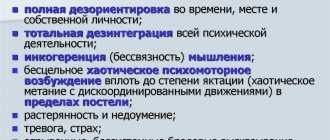Causes
Paraphrenic syndrome is not an independent disease. In psychiatry it is classified as a manifestation of paranoid schizophrenia. The occurrence of delusions and hallucinations can also occur in other diseases - delusional disorder and atherosclerotic psychoses.
The development of paranoid schizophrenia is based on genetic factors and environmental influences. Imbalance of neurotransmitters in the brain can be hereditary. Other reasons include:
- use of drugs and alcoholic beverages;
- severe acute and chronic stressful situations;
- unfavorable family environment, which is accompanied by violence;
- traumatic events.
These factors increase the severity of the imbalance of mediators in the structures of the central nervous system and lead to the development and progression of schizophrenia.
Classification with clinical features
Depending on the characteristics of the symptoms, it is customary to distinguish several types of paraphrenic syndrome:
- Hallucinatory. The patient hears internal and external voices that instill in him delusional ideas and also distort reality. In this state, the patient rarely enters into dialogue with others, proving that he is right.
- Systematized. Ideas are sustainable. They are orderly, although they are delusional. This type of disease is characterized by pronounced delusions of grandeur, superiority and a negative attitude towards other people. This behavior is accompanied by both auditory and visual hallucinations.
- Confabulatory. The patient has a combination of inflated self-esteem and memories of non-existent events in which he took a heroic part. This type of disorder rarely goes away on its own. It usually occurs as a result of complications of hallucinatory and systematized paraphrenia.
- Depressed or melancholic. The patient unreasonably considers himself guilty of actions that he did not commit. He assures everyone that he deserves punishment and humiliation, and tries to blame himself at every opportunity.
- Erotic. It affects women more often. Usually the cause is problems in family life. It seems to the patient that he is being reproached for immorality (adultery) and is promised to be punished by resorting to sexual violence. The disorder is intermittent and occurs in attacks.
- Late. Diagnosed in people over 70 years of age. Patients feel that their rights are constantly being violated and offended. The pathology relates to senile schizophrenia and is practically untreatable.
Depending on the nature of the disease, acute and chronic forms of paraphrenia are distinguished. In the first situation, the disease occurs suddenly and has a pronounced change in behavior - from euphoria to depression, and vice versa. The delusion in this case is unsystematized and is usually described as particularly important (for example, saving the planet).
In the chronic course of the disease, delirium is stable and systematized. Delusions of grandeur prevail. There are no sudden changes in behavior. The patient perceives his thoughts as truth and does not enter into arguments.
Clinical manifestations
The development of paraphrenic syndrome in schizophrenia is based on three symptoms:
- nonsense of various contents;
- mental automatisms;
- hallucinations and pseudohallucinations.
Delirium is a set of ideas and concepts that arose out of connection with the objective world. This condition is characterized by a thinking disorder in which the patient makes conclusions in isolation from incoming information and does not correct them. The content of delusional ideas varies. The most frequently identified delusions of persecution, relationship, and guilt. In the first case, the patient believes that the people around him pose a danger to him, they are trying to kill, steal things, etc. With delusions of attitude, the patient associates the behavior of his friends, colleagues or close relatives with a prejudiced negative attitude towards himself.
Mental automatisms in paraphrenia are the appearance of unusual feelings: alienation, unnaturalness of one’s own thoughts, movements and actions. The patient feels them imposed from the outside. At the same time, a person cannot stop thinking about “nested” thoughts and performing any actions.
Pseudohallucinations are a set of images that appear in the patient’s mind without the presence of a real object of perception. Images arise from an existing object or phenomenon. Hallucinatory content in paraphrenic syndrome varies, but is most often associated with delusional ideas.
Stages
Paraphrenic syndrome can act as one of the stages of various mental disorders. Experts include such deviations:
- Acute paraphrenia. The disorder is manifested by frequent bouts of delirium. The trigger for pathology is recent changes in a person’s life that bring significant inconvenience. In this case, the syndrome manifests itself as schizophrenia or symptoms of acute psychosis.
- Fantastic paraphrenia. This state is characterized by the ideas of omnipotence, power, greatness and wealth. The patient may experience hallucinations and partial loss of orientation in space.
- Chronic paraphrenia. Monotony of speech, a rather meager vocabulary, incoherent expressions and phrases, human lethargy - such symptoms are the main sign of this type of disorder.
Varieties of the syndrome
As already mentioned, paraphrenic syndrome is characterized by delusions, mental automatisms, hallucinations and pseudohallucinations. These conditions can be combined in various ways:
- Hallucinatory variant, based on perceptual disturbances. The patient exhibits pseudohallucinations and mental automatisms. Delusional ideas are weakly expressed.
- Depressive or melancholic paraphrenia - delusions associated with feelings of guilt, denial or punishment predominate. The patient believes that he brings only evil to the people around him. Characterized by disturbances in self-awareness and depression.
- With confabulatory paraphrenia, delusions of grandeur are most pronounced, combined with retrospective delusions and pseudohallucinations. In this regard, memory disorders are possible.
- A systematic disorder is manifested by delusions of persecution against the background of fantastic ideas. Auditory hallucinations and aggressiveness are characteristic. No memory impairments are detected.
- With manic or expansive paraphrenia, hyperactivity appears in combination with delusions of grandeur.
In addition to this classification, experts distinguish acute and late paraphrenia. The chronic form is characterized by a formed delusional system that can develop over months or years. In addition to delirium, speech disorders are detected. The patient has incoherent speech with broken individual sentences.
Acute paraphrenia develops in the form of paraphrenic psychosis. In this case, against the background of manic or depressive changes, pseudohallucinations and delusions are diagnosed.
There are also specific types of disorders:
- Involutionary type, associated with a combination of delusions of persecution and delusions of grandeur. Patients consider themselves an important figure in world events or the authors of important ideas, which are monitored by intelligence agencies, etc.
- The presenile type occurs in people aged 45 to 55 years, more often in women. Paraphrenia is associated with incipient degenerative changes in the frontal lobe cortex against the background of atherosclerosis and other somatic diseases. Symptoms are based on delusions of grandeur, which include visions of a sexual nature. In this case, aliens, God and other creatures often act as sexual partners.
- Late or senile form. Occurs in senile schizophrenia after the age of 70 years. Patients complain about their own uselessness for others, a negative attitude towards themselves on their part.
Identification of the specific type of paraphrenic syndrome is necessary for individual treatment. The prognosis does not depend on the prevailing clinical symptoms and is associated with the number of exacerbations.
Symptoms
Paraphrenic syndrome has a wide range of symptoms and manifests itself individually in each new case. It is believed that among the first three main signs of the disease are the presence of:
- Hallucinations, pseudohallucinations - the patient sees next to him unreal images of non-existent characters, talks about fantastic events taking place in his life that are completely divorced from reality.
- Mental automatism, suggesting that the patient’s own thoughts and actions are recognized as inspired by society. The disorder occurs simultaneously with delusional disorder.
one of the symptoms of paraphrenic syndrome: delusions of grandeur
Delusional ideas, including delusions of grandeur and persecution, when the patient regularly feels the participation of other people in his life (imaginary illusion).
Patients with paraphrenia become especially noticeable compared to healthy people when they are euphoric and very happy about something. It is at such moments that they consider themselves real rulers of the entire Universe and are capable of any action. During an attack of the disorder, patients may feel like famous writers or outstanding scientists. Some attribute to themselves such fantastic traits and unrealistic superpowers that they themselves cannot understand who they are. Along with this, hallucinations arise.
Speech also gives away a person with paraphrenia. She is solemn, commanding, emotional. She is able to inspire confidence in other people, convincing everyone that she is right, and also call on others to take decisive action. At the same time, delusional ideas are often supported by the statements of great classics and quotes from literature.
Those who are ill are constantly preparing for an upcoming grandiose event known only to them, for example, the impending end of the world or an alien invasion. Such unrealistic stories each time acquire new characters and increasingly rich colors. In addition, the patient begins to sincerely believe that his life is protected by real heroes, who once again emphasize his importance and increase self-esteem.
Quite often, the main symptom of paraphrenia is the delusion of a negative double, which was first described by Kapgrom. The patient believes that his close relative, or himself, has been replaced by an invisible double and it is he who commits all the negative actions. Over time, a person begins to get confused in personal relationships, not understanding who is a relative and who is a stranger.
Possible complications
Paraphrenic syndrome is one of the stages of the course of schizophrenia. Negative consequences in this condition are associated with the subsequent progression of the underlying disease and the development of the following complications:
- drug-resistant form of schizophrenia, characterized by a lack of effect from antipsychotics (with this type of disease, electroconvulsive therapy is possible);
- dementia against the background of degenerative processes in the cerebral cortex;
- persistent mental or neurological defect leading to a significant decrease in the level of quality of life and ability to work, the patient may become disabled.
In addition, the progression of paraphrenia poses a threat to the life of the patient himself and the people around him. Mental automatisms and delusions of persecution can push the patient to commit suicide or cause harm to the health of doctors, colleagues, relatives, etc.
Forms
In psychiatry, paraphrenic syndrome is usually divided into several types:
- Systematized paraphrenia. He is distinguished by regular attacks of delusional ideas and special confidence in his own greatness and superiority. The patient also believes that he has his own double, who commits all negative actions.
- Hallucinatory paraphrenia. It is characterized by the fact that the patient constantly sees unreal characters and is in a fictitious place. Moreover, he is completely sure that all mythical heroes really exist.
- Confabulatory paraphrenia. A condition that develops against the background of two previous types of syndrome. The sick person is disturbed by delusions of grandeur along with false memories of his own exploits and actions.
Diagnostic measures
The main method of diagnosis is psychiatric examination. The specialist determines the presence of delusional ideas, hallucinatory disorders and mental automatisms. Important information about the patient’s condition can be obtained from his relatives or colleagues, since the person himself is not critical of delirium and other disorders.
Of additional importance is the implementation of instrumental methods of examining the brain to exclude organic pathology. For this purpose, magnetic resonance imaging (MRI) and electroencephalography (EEG) are performed. MRI allows you to identify defects in changes in the structures of the central nervous system - tumor foci, cysts, consequences of neuroinfections, etc. EEG is used to study the functional activity of individual zones of the cerebral cortex. When changes are identified, the causes of their occurrence are identified and appropriate therapy is prescribed.
Differential diagnosis is carried out with paranoid and paranoid syndrome. Similar conditions occur against the background of schizophrenia and organic brain damage. They develop with a certain type of personality and the presence of provoking factors, while there is one main idea of delirium. Paraphrenic syndrome includes all of the above, except for monothematic delirium, and also has a greater severity of mental disorders.
Service price
- HOSPITAL Day hospital5 000
- Day hospital with intensive care8,000
- 24-hour hospital (all inclusive, cost per day) 11,000
- 24-hour hospital (all inclusive, cost per day). Single occupancy22 000
- 24-hour hospital (all inclusive, cost per day). Single occupancy in a superior room 33,000
- Primary family counseling for relatives of patients undergoing inpatient treatment free of charge
- Group psychotherapy for relatives of patients undergoing inpatient treatment free of charge
- Group psychotherapy for 24-hour and day hospital patients free of charge
Paraphrenia is a fantastic delirium of “particularly large scope”, combined with increased (rarely decreased) mood. A more severe form of delusion than paranoia and paranoid.
Patients feel like rulers of people, planets and the Universe, centers of the struggle between good and evil, sources or conductors of divine forces. Paraphrenic syndrome is an indicator of a gross disruption of the brain and psyche.
Paraphrenia literally means “beside the mind” in Greek. It was first described by the famous German psychiatrist Emil Kraepelin in 1907 as a separate disease. However, to date, this is not considered a separate disease, but is a syndrome (a combination of several symptoms) that can develop in various mental disorders.
Treatment approaches
Treatment of paraphrenic syndrome includes the use of medications and non-drug approaches. Therapy should be comprehensive and based on the individual characteristics of the patient and the course of the disease.
Treatment of acute paraphrenia
Therapy begins with the relief of an acute attack. For this, it is recommended to use antipsychotic drugs with pronounced antipsychotic activity - Olanzapine, Aminazine, Tizercin, etc. The latter is recommended for use in patients with melancholic disorders. If the patient has psychomotor agitation, then the drug of choice is Diazepam.
In addition to eliminating the acute attack, it is necessary to eliminate affective disorders. In the presence of depressive affect, antidepressants are prescribed:
- tricyclic drugs: Amitriptyline and its analogues;
- selective serotonin reuptake blockers: Fluoxetine, etc. (this group of drugs is recommended for use in patients with depressive paraphrenia).
In case of pronounced manic affect, mood stabilizers - lithium preparations - are prescribed simultaneously with neuroleptics. Their use allows you to normalize psychomotor agitation.
After stabilization of the condition, anti-relapse treatment begins. The main task of this stage is to prevent the development of repeated attacks. The duration of therapy depends on the number of exacerbations: for a single episode - 6 months, for a repeated episode - 2 years, for three or more exacerbations - for life. Antipsychotics are used: Olanzapine or Rispolept. Drugs in low dosages do not have side effects, but have a significant therapeutic effect.
Treatment of chronic paraphrenia
Hospitalization for the chronic form of paraphrenic syndrome is not indicated. Treatment is carried out on an outpatient basis under the supervision of a psychiatrist. Therapy is based on the use of medications:
- neuroleptics (Risperidone, Olanzapine, etc.) in low dosages to prevent delusions and hallucinations (they are highly effective and can be used for life);
- antidepressants (Fluoxetine, etc.) in the presence of melancholic paraphrenia. Take until symptoms of depression disappear.
Normotimics (lithium salts), anticonvulsants (valproic acid) and other symptomatic drugs can also be used. Medicines are used only after being prescribed by the attending physician, since they all have a fairly wide list of contraindications.
Psychotherapy is important in anti-relapse treatment. Individual consultations with a psychotherapist are recommended for patients with paraphrenic syndrome. The specialist helps the patient in social rehabilitation and in solving personal problems.
Treatment
Treatment for the disorder is possible. It is carried out in several stages. First, patients are prescribed antipsychotic drugs; they help stabilize the patient’s general condition and, in addition, reduce delirium. If there is also a depressive disorder, the doctor prescribes antidepressants. Patients take medications in large dosages while in hospital treatment; at home they only continue to take a small dose of medication. The final stage of treatment is a course of psychotherapy with a specialist.
Forecast
The prognosis is favorable. With timely detection of the disease and the prescription of complex treatment after the first manifestations of paraphrenia, recovery is observed in 85-90% of patients. Subsequent anti-relapse therapy for six months minimizes the risk of exacerbation.
The prognosis worsens when the condition recurs. With 3 or more exacerbations, complete recovery is impossible. Such patients require lifelong treatment with antipsychotics. If you refuse them due to provoking factors, the symptoms of paraphrenia return.
In the absence of treatment or its improper implementation, schizophrenia progresses. It can lead to severe mental or neurological defects. Therapy in this case does not improve the condition and recovery.
Prevention
Knowing what paraphrenic syndrome is and starting its treatment in a timely manner, you can protect yourself or your loved ones. The more advanced the symptoms, the more difficult it is to cure them. Of course, most patients manage to recover, but this does not happen to everyone. At risk are older people, whose health should be carefully monitored and remember to visit a psychiatric clinic at least once every six months for examination.
Paraphrenic syndrome is, first of all, a manifestation of the underlying disease, and not an independent nosological unit. Prevention consists of avoiding stress, injury, and giving up bad habits. Lifestyle correction in the form of regular physical activity, sports, normalization of the sleep-wake regime.
If necessary, contact a psychotherapist in order to reduce stress levels and understand yourself and get rid of worries. If you feel that this is not enough, then, under the supervision of a doctor, you can take a course of sedatives, antidepressants, tranquilizers, and mood stabilizers, depending on the severity of your emotional state and clinical symptoms.
The main thing to remember is that even if there is a predisposition to a mental disorder, it may not manifest itself at all throughout life if you take care of yourself and avoid emotional exhaustion.











